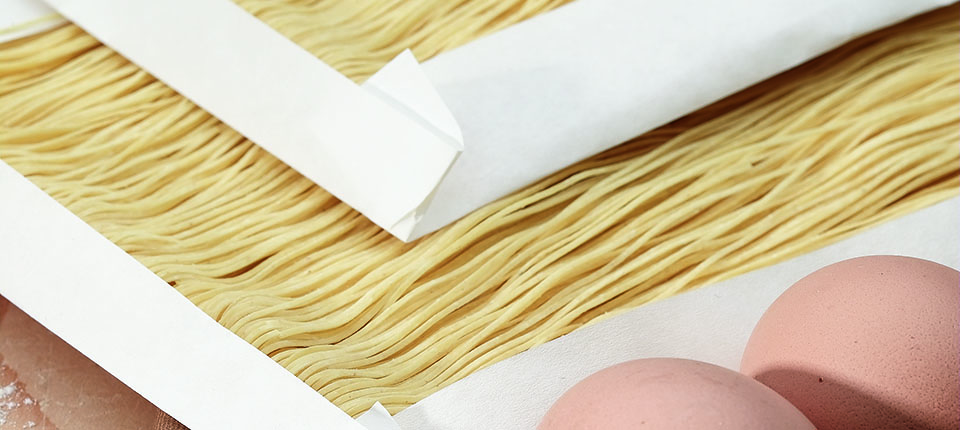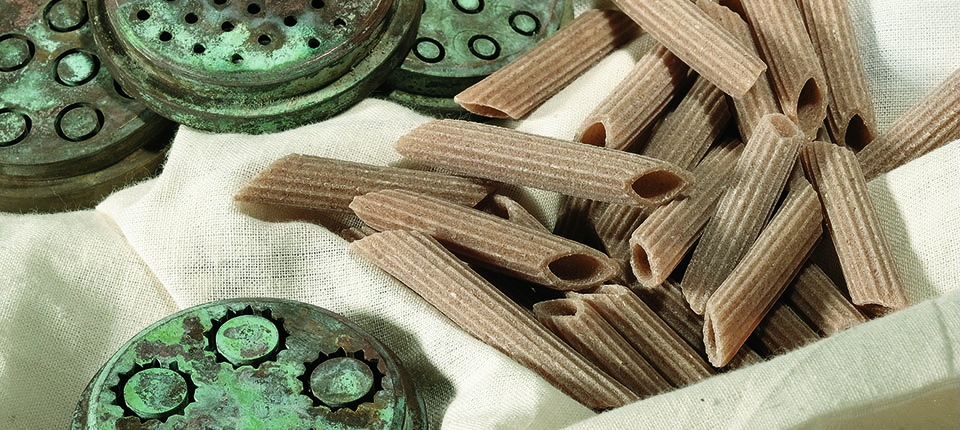
Measuring pasta quality parameters
12 February 2014The quality of pasta resides in a series of characteristics that are affected both by the properties of the raw materials and by the production process. The quality of pasta can be established by measuring a number of its characteristics which are considered the most important pasta quality parameters, such as colour, firmness during cooking and texture properties. In this article, the methods most commonly used for measuring these.
by Elena Curti and Eleonora Carini
The quality of pasta resides in a series of characteristics that are affected both by the properties of the raw materials and by the production process.
The quality of pasta can be established by measuring a number of its characteristics which are considered the most important pasta quality parameters, such as colour, firmness during cooking and texture properties. In this article, the methods most commonly used for measuring these parameters are described.
Colour
High quality pasta (either fresh or dried) is normally yellow in colour and can be measured using a variety of techniques.
The most widely used technique is colorimetry. The measuring of the colour using colorimetry involves the use of a reflectance spectrophotometer which, through a beam of light in the visible range (400-800 nm), makes it possible to measure the three colorimetric coordinates L*, a* and b* in the CIELAB measuring system. The colorimetric coordinate L* represents the lightness value in the range 0 (black) – 100 (white); the colorimetric coordinate a* represents the green (negative values) – red (positive values) colour range and the colorimetric coordinate b* (yellowness) represents the blue (negative values) – yellow (positive values) colour range. As far as pasta is concerned, it is the colorimetric coordinate b* that assumes the greatest importance, as it represents the colour yellow. The instrument is simple to use and results can be obtained rapidly. It is therefore ideal for taking measurements during in-line product controls.
Another technique that can be used to determine the colour of pasta is image analysis. This technique is more complex than colorimetry, since various steps are required to obtain the measurement of the colour. The technique is based on the acquisition of a digital image and of its subsequent processing using dedicated software. The image must be processed with extreme precision and requires special calibration in order to obtain a measurement faithful to the real colour of the sample under examination. Due to these “limitations”, this technique is not practical for in-line industrial controls, but is more suited to in-depth pasta research and development activities.
Firmness during cooking
The ‘measurement’ of the pasta’s firmness during cooking is generally connected with two different parameters: the water absorbed during cooking and the solids lost to cooking. These parameters are measured on pasta samples, duly prepared and cooked.
The first step involves calculating the optimum cooking time. The official method (AACC 66-50.01) involves cooking a given quantity of spaghetti in distilled water, and then compressing a single strand of spaghetti between two thin glass plates at different cooking times. The optimum cooking time corresponds to the time required for the disappearance of the ‘white core’ (non gelatinised starch) in the heart of the strand following compression. Also for the other pasta shapes, representative samples/sections have to be prepared and then compressed in order to evaluate the disappearance of their ‘white core’.
This is followed by the cooking of a sample of pasta (with a known weight) in a pre-set quantity of water (usually distilled) on the basis of the optimum cooking time, or of lower or higher cooking times (in the case of more in-depth studies on the properties of cooked pasta).
After cooking, the pasta must be carefully drained and cooled for a standardised period of time that is always kept constant, before proceeding with the planned analyses.
The water absorbed during cooking (water-absorbing capacity) can be measured by weighing the pasta after cooking, and comparing this with its initial weight. The calculation of the solids lost to cooking is one of the most important parameters for determining the quality of cooked pasta and this article deals with the two main measuring methods, which involve collecting all the pasta cooking water.
The first method (AACC 66-50.01) involves completely drying the cooking water in a convection oven at a temperature of 105°C until a constant weight is reached. The solid residue remaining (g solids/100 g pasta) after the drying procedure consists of the solids released by the pasta during cooking. A quality pasta with a correctly structured gluten network will tend to lose a small amount of solids to cooking.
The second method involves the sedimentation of the solids present in the cooking water through the use of transparent graduated conical containers (Imhoff cones). The cooking water is poured into the cone and the cone is then filled to the top with distilled water (the cone usually holds one litre). The next step is the first phase of sedimentation, which lasts 24 hours; this is then followed by a stirring phase to make the liquid inside the cone uniform. Sedimentation is then repeated for a further 24 hours. The solids released correspond to the volume of sediment, determined by reading the corresponding level on the graduated cones. It is important to point out that this method, in addition to having longer analysis times, also presents results with a rather wide margin of variability.
There is a third method which involves the analytical determination of the quantity of organic substances (Total Organic Matter – TOM) released by the cooked pasta during an extremely precise ‘washing’ operation. The pasta is drained and ‘washed’ with a given quantity of water which serves to remove the organic matter from the surface of the pasta; a pre-set quantity is then removed and subjected to drying in the oven at 80°C.
The organic matter is then measured through titration with ferrous ammonium sulphate in excess of potassium dichromate, according to the formula below:
TOM (g/100g pasta) = ((B-S)* 20/B) * Fd* 0.00347, where B is the ferrous ammonium sulphate used for the white expressed in ml, S is the ferrous ammonium sulphate used to titrate the sample expressed in ml, Fd* is the dilution factor and 0.00347 is a correction factor for the incomplete transformation of the starch into glucose (97.25%) (D’Egidio et al., 1976).
Texture properties
The texture properties of the pasta after cooking are extremely important macroscopic chemical-physical properties for assessing the quality of the pasta, given the fact that they represent some of the characteristics that the consumer is more attentive to at the moment of consumption. Therefore producing a pasta with certain characteristics becomes one of the most important factors for the industry which aims at selling a quality product; so the measuring of these properties is of fundamental importance to pasta factories wishing to characterise their pasta. On the basis of the results obtained from the measuring of the texture properties, the pasta manufacturer may make some changes in the formulation and/or production process, with a view to improving its product.
But what changes can be made and what texture properties should quality pasta ideally have? In order to evaluate the quality of the pasta after cooking, we have to consider several parameters such as firmness, springiness, stickiness, cohesiveness, the work entailed in shearing/extruding etc.
As we know only too well, the Italian consumer demands high quality standards with regard to these characteristics, i.e. the pasta must be firm to the bite (“al dente”) and not become sticky during chewing. These characteristics are not necessarily so important to the international consumer, who might actually prefer a pasta that is less “resistant” in keeping with the habits and cooking methods of his/her own country.
To measure these characteristics numerous sensory and instrumental tests have been developed over the years.
As far as sensory analysis is concerned, this is still used today to calculate the stickiness of cooked pasta in the quality control laboratories of certain pasta factories, through panels of trained tasters. These sensory techniques can be extremely useful for the creation of an internal database and in order to monitor quality changes in the pasta over the course of time. However, sensory evaluation should be considered a subjective technique. In fact, various studies report that the relation/correlation between the data obtained from sensory and instrumental techniques is very variable, underlining that a comparison of the results of different panels is only able to distinguish major differences between samples.
The sensory analysis also has the disadvantage of being extremely expensive (particularly for small-to-medium sized companies) and difficult to manage when the samples are very small or in excessive numbers. During the research phase, it might even be necessary to prepare 40-50 sensory taste samples in a single day.
In order to avoid these problems, various instrumental methods have been developed which are more rapid, considerably less expensive and, even more important, they guarantee a more objective interpretation of the properties.
The texture measurements can be carried out by applying small or large deformations to the study sample. Rheometers can be used to measure the fundamental rheological properties of the cooked pasta (which some authors relate to the initial perception on the palate) through the application of small deformations.
For large deformations, the texture measuring instrument used is the dynamometer which, in the majority of cases is a Texture Analyzer (produced by Stable Macro Systems, http://www.stablemicrosystems.com/?gclid=CJbM2ZCWobQCFVC7zAodriAA8Q).
Purchasing and equipping this type of instrumentation requires investments in the region of €20-30,000, in addition to personnel training costs.
The official method AACC Pasta and Noodle Cooking Quality — Firmness (66-50.01), approved for the first time in 1989, is probably the most widely used method for determining the texture of cooked pasta, particularly for long-cut pasta shapes such as spaghetti and noodles. It often becomes a problem to use this test for short-cut pasta shapes due to the difficulty experienced in adapting samples with irregular geometry to the test, and in preventing them from moving during the experiment. In order to overcome these problems the Kramer shear cell is often used for measuring short-cut shapes, especially those with irregular geometries.
A great deal of research has been conducted to study the various probes to be used to determine the texture of the pasta after cooking. The probes studied have been classified in two groups on the basis of the type of physical action exerted on the sample during the test. The first type includes probes that exert a shearing force such as the blade (official method, TA-47), the Kramer shear cell (with 5 blades, TA-245) and the mini Kramer shear cell (with five blades, TA-91 M). Other probes are of the type that apply a compression force, for example the Ottawa cell (TA-245) and a probe called the firmness-stickiness rig (HDP-PFS).
As an alternative to the compression test, some researchers have experimented tensile type tests, by measuring the extension of cooked spaghetti following the application of an increasing tensile load. This test is not widespread in the industry despite the fact that it is commonly used to measure the texture of cooked noodles. Some studies indicate that the parameters measured by tensile stress do not correlate with the attributes measured with sensory techniques.
Some technical details of the most commonly used measuring methods are shown below.
Official method AACC 66-50.01 with pasta blade TA-47
This method is used for cooked spaghetti and noodles both in the industrial sector and in scientific research. The probe used is a blade (made of Plexiglas or Lexan, Figure 1) which is easy to use and clean, and which has a shearing surface of 1 mm. This test measures the work (N * m or N * s) required to cut 5 strands of spaghetti positioned one next to the other. Difficulties may be encountered when, as mentioned before, small and irregular pasta shapes have to be measured; moreover, the “tested” area of the sample is limited and this can present a problem when measuring the texture properties of pasta produced with non conventional formulations (in which the sample may be physically lacking in homogeneity due to the adding of other ingredients). This test is usually carried out at a speed of 0.1-1 mm/s.
The firmness, expressed in g or N) is measured as the maximum force recorded in the Force-Distance/Time graph; another parameter that can be obtained is the Work required to shear the sample (N * m or N * s) corresponding to the area under the curve.
Test for measuring firmness and stickiness with the “firmness-stickiness rig” (HDP-PFS)
This probe is generally used to perform a double compression test TPA (Figure 2). Even although it involves the disassembling, cleaning and reassembling of the equipment, it is nonetheless a fairly rapid test. The base of the probe is made of aluminium. The properties that can be measured are firmness, springiness, stickiness and cohesiveness.
Shear-compression test with the Kramer shear cell
This test is used at an industrial level (but also in the scientific field) for shapes with large diameters/widths. The test consists in bringing down the 5 blades (Figure 3) along the grooves in the cell and, depending on the speed selected, compressing and partially extruding the pasta through the holes in the base of the cell (of the same dimensions as the compression area of the 5 blades) Also in this case, the properties that can be measured are the firmness and the work required to compress, shear and extrude the sample. This test destroys the sample and involves lengthy measuring times since each time the probe is used it has to be disassembled, meticulously cleaned (as pieces of pasta get jammed between the blades) and reassembled. It cannot be used for the TPA test since the test destroys the sample.
Compression-extrusion test with the Ottawa cell (TA-245)
The test applies a compression force with consequent extrusion. Both the base of the probe (60 X 60 mm, 67 holes each 6 mm in diameter) and the probe itself (made up of numerous dies), are made of aluminium. The tolerance between the die and the corresponding joint is very limited, so it is quite laborious to standardise the parameters of the test. The properties that can be measured are firmness, springiness and work.
Keep reading, download the magazine
 PASTARIA DE (digital edition) 2013 n. 1 (ITALIANO) (30.6 MiB, 3,802 download)
PASTARIA DE (digital edition) 2013 n. 1 (ITALIANO) (30.6 MiB, 3,802 download)
Registrazione necessaria. Sign-up to download.
 PASTARIA INTERNATIONAL DE (digital edition) 2013 n. 1 (ENGLISH) (29.3 MiB, 1,797 download)
PASTARIA INTERNATIONAL DE (digital edition) 2013 n. 1 (ENGLISH) (29.3 MiB, 1,797 download)
Registrazione necessaria. Sign-up to download.


